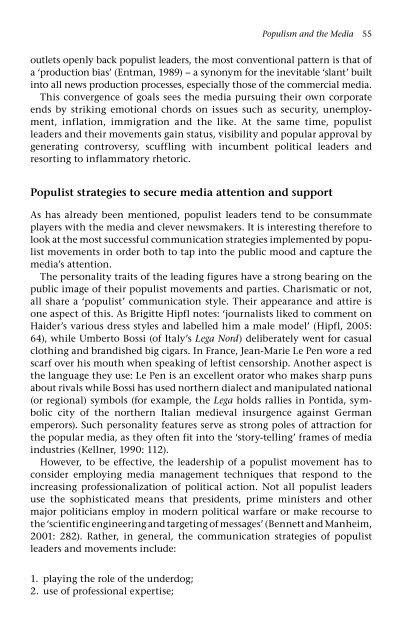Twenty-First Century Populism: The Spectre of Western European ...
Twenty-First Century Populism: The Spectre of Western European ...
Twenty-First Century Populism: The Spectre of Western European ...
Create successful ePaper yourself
Turn your PDF publications into a flip-book with our unique Google optimized e-Paper software.
<strong>Populism</strong> and the Media 55<br />
outlets openly back populist leaders, the most conventional pattern is that <strong>of</strong><br />
a ‘production bias’ (Entman, 1989) − a synonym for the inevitable ‘slant’ built<br />
into all news production processes, especially those <strong>of</strong> the commercial media.<br />
This convergence <strong>of</strong> goals sees the media pursuing their own corporate<br />
ends by striking emotional chords on issues such as security, unemployment,<br />
inflation, immigration and the like. At the same time, populist<br />
leaders and their movements gain status, visibility and popular approval by<br />
generating controversy, scuffling with incumbent political leaders and<br />
resorting to inflammatory rhetoric.<br />
Populist strategies to secure media attention and support<br />
As has already been mentioned, populist leaders tend to be consummate<br />
players with the media and clever newsmakers. It is interesting therefore to<br />
look at the most successful communication strategies implemented by populist<br />
movements in order both to tap into the public mood and capture the<br />
media’s attention.<br />
<strong>The</strong> personality traits <strong>of</strong> the leading figures have a strong bearing on the<br />
public image <strong>of</strong> their populist movements and parties. Charismatic or not,<br />
all share a ‘populist’ communication style. <strong>The</strong>ir appearance and attire is<br />
one aspect <strong>of</strong> this. As Brigitte Hipfl notes: ‘journalists liked to comment on<br />
Haider’s various dress styles and labelled him a male model’ (Hipfl, 2005:<br />
64), while Umberto Bossi (<strong>of</strong> Italy’s Lega Nord) deliberately went for casual<br />
clothing and brandished big cigars. In France, Jean-Marie Le Pen wore a red<br />
scarf over his mouth when speaking <strong>of</strong> leftist censorship. Another aspect is<br />
the language they use: Le Pen is an excellent orator who makes sharp puns<br />
about rivals while Bossi has used northern dialect and manipulated national<br />
(or regional) symbols (for example, the Lega holds rallies in Pontida, symbolic<br />
city <strong>of</strong> the northern Italian medieval insurgence against German<br />
emperors). Such personality features serve as strong poles <strong>of</strong> attraction for<br />
the popular media, as they <strong>of</strong>ten fit into the ‘story-telling’ frames <strong>of</strong> media<br />
industries (Kellner, 1990: 112).<br />
However, to be effective, the leadership <strong>of</strong> a populist movement has to<br />
consider employing media management techniques that respond to the<br />
increasing pr<strong>of</strong>essionalization <strong>of</strong> political action. Not all populist leaders<br />
use the sophisticated means that presidents, prime ministers and other<br />
major politicians employ in modern political warfare or make recourse to<br />
the ‘scientific engineering and targeting <strong>of</strong> messages’ (Bennett and Manheim,<br />
2001: 282). Rather, in general, the communication strategies <strong>of</strong> populist<br />
leaders and movements include:<br />
1. playing the role <strong>of</strong> the underdog;<br />
2.<br />
use <strong>of</strong> pr<strong>of</strong>essional expertise;



